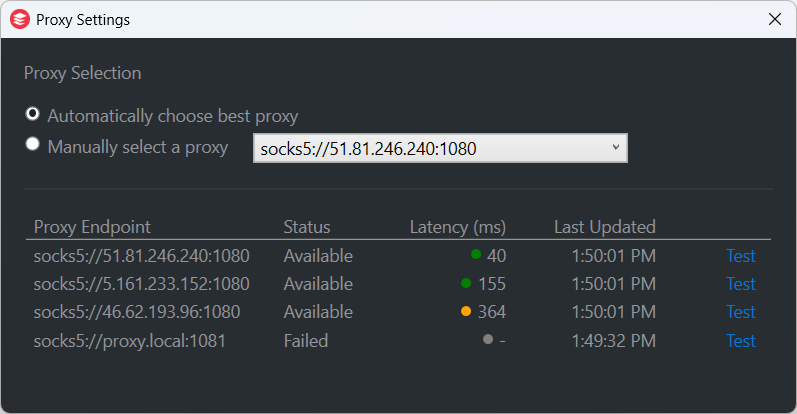Appearance
Proxy Settings
Configure and test SOCKS proxy connections for the Turbo Launcher. The Proxy Settings dialog helps you select the best proxy server and troubleshoot connection issues.
What you'll learn
- Viewing available proxy servers
- Testing proxy connectivity
- Selecting automatic or manual proxy mode
- Troubleshooting proxy connection issues
Overview

The Proxy Settings dialog displays available SOCKS proxy servers. Each proxy shows its connection status, latency, and last test time.
Proxy List
The proxy list displays:
- Endpoint: The proxy server address and port
- Latency: Response time in milliseconds (or "-" if untested)
- Status: Available, Pending, or Failed
- Last Updated: When the proxy was last tested
Proxies are sorted automatically with the best-performing (lowest latency) proxies at the top.
Status Indicators
- Green: Good performance (< 200ms)
- Orange: Fair performance (200-499ms)
- Red: Poor performance (≥ 500ms)
- Gray: Not yet tested or failed
Testing Proxies
Click the Test button next to any proxy to check its connectivity. The test:
- Runs 3 connection attempts with a 5-second timeout each
- Measures response time (latency)
- Shows median latency from successful attempts
- Provides contextual troubleshooting suggestions on failure
Test Results
- Success: Shows the measured latency and saves it to proxies.json
- Failure: Shows an error dialog with the problem and suggested solutions
Common error scenarios:
- Host not found: Verify the server address and DNS settings
- Connection refused: Check that the proxy server is running
- Timeout: Check network connectivity and firewall settings
- Authentication failure: Verify your credentials
Proxy Selection
Automatic Mode (Recommended)
The system automatically selects the best-performing proxy based on latency measurements. This is the default mode and works well for most users.
Manual Selection
Choose a specific proxy from the list. Your selection is saved and will be used for all Turbo operations until you change it.
To switch between modes, use the radio buttons at the top of the dialog.
Configuration File
Proxy settings are stored in proxies.json. The file updates automatically when:
- You manually test a proxy
- You change your proxy selection
- The Sandbox Service periodically tests proxies
- Turbo operations measure and update proxy performance
The Launcher monitors this file and updates the proxy list automatically when changes are detected.
Next Steps
- Policy System: Configure security policies
- Troubleshooting: Proxy connection issues
